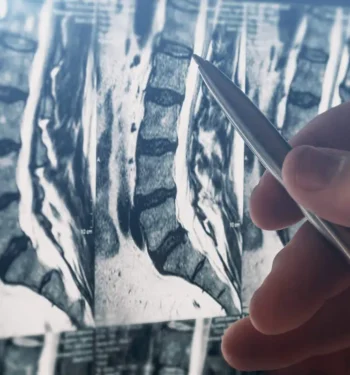
Cervical spinal stenosis affects millions of Americans, yet many people don’t fully understand the seriousness of the condition until it significantly impacts their daily life. This narrowing of the spinal canal in the neck can cause debilitating symptoms that worsen over time without proper treatment.
If you’re experiencing neck pain, tingling, or weakness in your arms and hands, you might be dealing with cervical spinal stenosis. Understanding the symptoms, stages, and treatment options can help you make informed decisions about your care. For people seeking spinal stenosis treatment in Indiana, Goodman Campbell Brain and Spine offers expert, comprehensive care tailored to your needs—helping you relieve pain, restore function, and regain your quality of life.
Introduction to Cervical Spinal Stenosis
Cervical spinal stenosis occurs when the spinal canal in your neck becomes narrowed, putting pressure on the spinal cord and nerve roots. This condition primarily affects the seven vertebrae in your neck, known as the cervical spine.
The spinal canal houses your spinal cord, which carries nerve signals between your brain and body. When this space becomes constricted, it can compress the spinal cord and nearby nerves, leading to pain, numbness, and weakness.
Several factors increase your risk of developing cervical spinal stenosis:
- Age-related wear and tear
- Arthritis and bone spurs
- Herniated discs
- Thickened ligaments
- Previous neck injuries
Early recognition and treatment are crucial for preventing permanent nerve damage. How serious is spinal stenosis in the neck? Without proper intervention, this condition can lead to significant disability and loss of function.
If you’re experiencing cervical spinal stenosis symptoms, request an appointment at Goodman Campbell for an expert evaluation and path forward.
What Are the Symptoms of Cervical Spinal Stenosis?
Cervical spinal stenosis symptoms typically develop gradually and may include:
- Neck pain and stiffness
- Tingling or numbness in arms and hands
- Weakness in the upper extremities
- Difficulty with fine motor tasks like buttoning shirts
Cervical Stenosis Symptoms C5-C6:
The C5-C6 level is commonly affected, causing specific symptoms such as:
- Shoulder and arm weakness
- Loss of coordination in hands
- Difficulty gripping objects
- Numbness extending from the neck to the thumb
Progressive Symptoms:
As the condition advances, symptoms may worsen and include:
- Increased pain and stiffness
- Balance problems
- Difficulty walking
- Muscle weakness throughout the body
What Are the Worst Symptoms of Spinal Stenosis?
In severe cases, cervical spinal stenosis can cause:
- Loss of bladder or bowel control
- Paralysis in arms or legs
- Severe balance problems
- Complete loss of sensation
These serious symptoms require immediate medical attention. Get started by making an appointment at Goodman Campbell.
What Are the Stages of Cervical Spinal Stenosis?
Understanding the stages of cervical spinal stenosis is key to determining the most appropriate treatment approach. Generally, the condition progresses through three core stages: mild, moderate, and severe — each with its own distinct characteristics.
In the mild stage, the spinal canal experiences only minimal narrowing. Patients may have occasional neck pain or stiffness, and symptoms often come and go. Imaging, such as an MRI, may reveal only slight compression of the spinal cord.
Moderate stenosis involves more noticeable narrowing and increased pressure on the spinal cord. Symptoms such as tingling, numbness, and discomfort become more frequent and persistent. A CT scan or MRI will typically show a more significant level of compression.
Severe cervical spinal stenosis is characterized by marked narrowing and substantial spinal cord compression. Patients often experience constant symptoms that interfere with daily activities, including weakness, coordination difficulties, and balance issues. Advanced imaging will reveal critical levels of compression requiring more urgent intervention.
If you’re experiencing persistent neck pain that lasts more than a few days, numbness or tingling in your arms, muscle weakness, or trouble with balance and walking, it’s essential to consult a healthcare provider who specializes in spine care. Early intervention can help slow or prevent the progression of symptoms.
Goodman Campbell offers advanced diagnostic imaging and comprehensive treatment planning to help patients manage cervical spinal stenosis at every stage of the condition. Talk to your doctor to learn more about your options or request an appointment today.
How Serious Is Spinal Stenosis in the Neck?
How serious spinal stenosis in the neck becomes depends on several factors, including the extent of spinal cord or nerve compression and how quickly treatment is initiated. When left unaddressed, cervical spinal stenosis can lead to serious, even permanent, complications.
Potential complications include chronic pain, long-term disability, and, in some cases, irreversible nerve damage. As the condition progresses, many patients begin to wonder: What are the worst symptoms of spinal stenosis? In the most severe cases, the answer includes complete paralysis, loss of sensation, and significant loss of motor function. These outcomes highlight the critical importance of early diagnosis and timely intervention.
Cervical spinal stenosis can also have a profound impact on daily life. Work performance and productivity may decline, and activities that were once enjoyable — hobbies or exercise — can become difficult or impossible. Sleep quality often suffers due to ongoing discomfort, and even basic daily tasks may require increasing levels of assistance, which can impact a person’s independence.
One of the most serious risks is the potential for permanent nerve damage. Compressed nerves, if not treated, can lose function entirely. Among the worst symptoms associated with spinal stenosis are complete paralysis and loss of sensation — outcomes that underscore the urgency of appropriate care.
Regular monitoring by an experienced spine specialist is essential. Ongoing follow-up allows for early detection of worsening symptoms, timely updates to treatment strategies, and the prevention of long-term complications. Staying proactive can lead to better long-term outcomes and improved quality of life.
Ask your doctor about Goodman Campbell’s multidisciplinary and interdisciplinary care, and monitoring and support services to ensure you receive expert guidance throughout your care journey.
How Do You Treat Cervical Spinal Stenosis?
Cervical spinal stenosis treatment depends on symptom severity and individual needs. Many patients start with conservative options such as physical therapy, anti-inflammatory medications, posture improvements, and heat or cold therapy. If conservative care isn’t enough, an interventional pain management physician might administer interventional procedures such as epidural steroid injections, nerve blocks, or radiofrequency ablation to help manage symptoms. For those exploring the latest options, it’s common to ask, “What is the newest treatment for spinal stenosis?” Promising advancements include anterior cervical discectomy and fusion — a minimally invasive surgery commonly known as ACDF — artificial disc replacement, and spinal cord stimulation.
Surgery may be necessary when symptoms significantly impact quality of life or when neurological function declines due to severe compression. Ask your doctor about Goodman Campbell’s comprehensive treatment options, including advanced, minimally invasive techniques designed to restore function and reduce pain.
What Should I Not Do With Cervical Stenosis?
Certain activities can worsen cervical spinal stenosis symptoms or increase the risk of injury. In general, patients should avoid heavy lifting above shoulder level, high-impact sports, and movements that strain or twist the neck excessively.
Poor posture and ergonomics also contribute to symptom flare-ups, often resulting in unnecessary and repetitive neck strain. Try not to look down for long periods, avoid sleeping on your stomach, and ensure your computer setup supports good neck alignment.
At work, simple changes like raising your monitor to eye level, using ergonomic tools, and taking frequent breaks can help. A standing desk may also be beneficial for maintaining better posture throughout the day.
Avoid self-treating with aggressive neck movements or unproven remedies. If your symptoms worsen, don’t delay seeking care.
These are just a few examples of things to avoid with cervical spinal stenosis to help reduce flare-ups and prevent further damage. Request an appointment to learn more about Goodman Campbell’s ergonomic assessments and workplace recommendations to protect your neck and support recovery.
Can You Live a Long Life With Cervical Stenosis?
The short answer is “yes” — many patients live long lives with cervical spinal stenosis, especially with early diagnosis, proper treatment, and ongoing management. The outlook often depends on the severity of symptoms, overall health, and how well a person follows medical advice.
Long-term care may include regular physical therapy, lifestyle changes, and routine check-ins with your doctor. These steps can help reduce pain, maintain mobility, and prevent future complications.
Many people with cervical stenosis continue to work, enjoy hobbies, and stay socially active. Managing stress and making ergonomic adjustments can also support a better quality of life.
Regular follow-up is key to monitoring progress and making timely treatment adjustments. Goodman Campbell can be your long-term partner in caring for and managing your cervical spinal stenosis. Request an appointment to begin your path forward to help you stay healthy and active for years to come.
Next Steps for Managing Cervical Spinal Stenosis
Cervical spinal stenosis is a serious condition that requires prompt medical attention and comprehensive care. Early diagnosis and appropriate cervical spinal stenosis treatment can help prevent permanent damage and preserve your quality of life.
Key points to remember:
- Symptoms often progress gradually but can become severe
- Multiple treatment options are available
- Early intervention leads to better outcomes
- Ongoing medical care is essential
The most important step is discussing your symptoms with an experienced spine specialist and team who can properly evaluate your condition and recommend personalized, appropriate treatment options.
Don’t let cervical spinal stenosis control your life. Ask your doctor about Goodman Campbell‘s expert spine care services and comprehensive treatment approach. Our experienced team is dedicated to helping you achieve pain relief and restore your active lifestyle.


